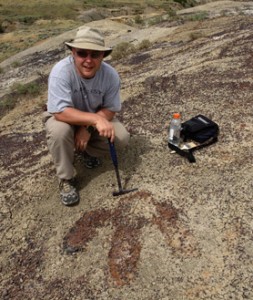The Mystery Tyrannosaur Footprint – A Rare Fossil Discovery
Single Theropod track from the Hell Creek Formation
It never ceases to amaze us how a footprint made by an animal millions of years ago is able to be fossilised and then exposed to the elements in such a way that it can be found before it erodes away. Although dinosaur tracks and footprints have been found all over the world, they are much rarer than fossilised bones. Footprints are extremely delicate structures and it is only by incredible luck that they get preserved at all.
Mystery Tyrannosaur Footprint
The ground the animal was walking on must be soft enough to allow an impression to be made, yet it cannot be too soft or deformation will occur. Mud is a typical candidate for a footprint but mud indicates water and if there is a water source nearby then animals will congregate and could trample all over the footprint, churning the ground over and turning the site into an indistinguishable mess. The tramplings of dinosaurs weighing several tonnes can wreck havoc on any trackways – scientists have even coined a special word for this sort of damage – dinoturbation.
If the footprint is lucky enough to avoid getting puddled into oblivion then the print needs to be covered by something that will protect it, a sediment such as fine sand grains, for example.
Presuming fossilisation and preservation occurs then the print must remain intact and then erode out from the surrounding matrix facing exposure once again. The elements can erase any impression, through erosion processes such as freeze and thaw, and then someone who can distinguish a footprint from the surrounding debris needs to find it.
This explains why prints are so rare…
Fortunately, Dr Phil Manning of the University of Manchester was able to spot this exciting meat-eaters’ footprint.
Dr Phil Manning with his Late Cretaceous Theropod Footprint
Source: Dr Phil Manning (University of Manchester)
Tyrannosaurus rex Track?
It has been speculated that this print could have been made by a Tyrannosaurus rex, but it is difficult to be certain as unless an animal is found at the end of the trackway, palaeontologists can only really make educated guesses. It is certainly the footprint of a theropod (the three toes give it away), it might be a T. rex print, possibly the first ever found or it could equally have been made by a relative of T. rex, the smaller Nanotyrannus (nomen dubium) that also lived at the same time as the “King of the Dinosaurs”. It could even belong to a completely unknown genus.
Please note Nanotyrannus is a disputed dinosaur genus.
The print will need to be carefully studied so we can gain as much information about it as possible. However, for us, that is for another day, it is just marvellous to wonder at it and to think that it managed to survive 67 million years for us to be able to view it at all.
To read the first web log article on this footprint: Possible Tyrannosaurus rex footprint found.


